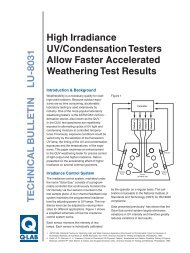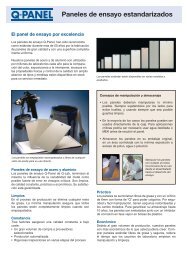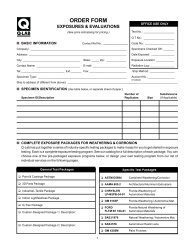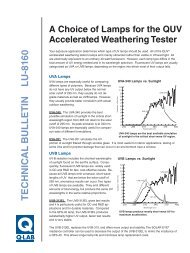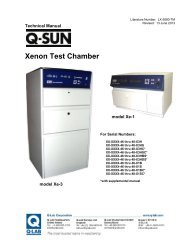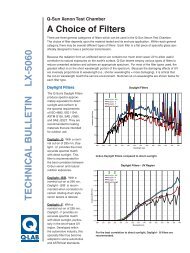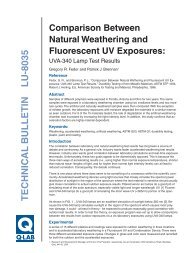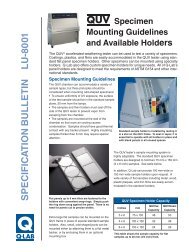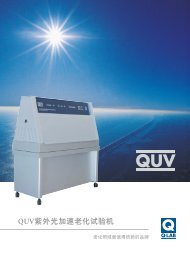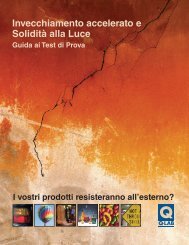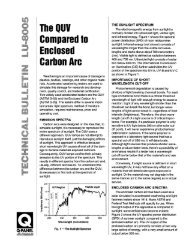PR ODUCT SUMMAR Y LU-0805 - Q-Lab
PR ODUCT SUMMAR Y LU-0805 - Q-Lab
PR ODUCT SUMMAR Y LU-0805 - Q-Lab
Create successful ePaper yourself
Turn your PDF publications into a flip-book with our unique Google optimized e-Paper software.
Accelerated<br />
Weathering Tester<br />
<strong>PR</strong><strong>ODUCT</strong> <strong>SUMMAR</strong>Y <strong>LU</strong>-<strong>0805</strong><br />
The QUV ® tester’s short wavelength, ultraviolet light, and moisture cycles realistically simulate the<br />
damaging effects of sunlight, dew, and rain. You can generate reproducible and reliable weathering<br />
data in just a few weeks or months, with excellent correlation to outdoor weathering tests.<br />
QUV Tester Features<br />
• SOLAR EYE ® Irradiance Control<br />
• Condensation System Uses Tap Water<br />
• Quick & Easy Calibration with AutoCal<br />
• Small Footprint / Large Capacity<br />
Ultraviolet Sunlight<br />
The QUV machine uses fluorescent UV lamps to<br />
reproduce the damaging effects of sunlight. Although<br />
UV light makes up only about 5% of sunlight, it is<br />
responsible for most of the sunlight damage to polymer<br />
materials exposed outdoors. Therefore, it is only<br />
necessary to reproduce the short wavelength UV for<br />
testing polymer degradation.<br />
Several types of UV lamps are available for the QUV accelerated weathering tester. Each lamp type<br />
differs in the total amount of UV energy emitted and in wavelength spectrum. For example, the UVA-<br />
340 lamp offers the best correlation to outdoor exposures because it is the best simulation of sunlight<br />
from 295 nm to 365 nm. The UVB-313 lamp offers maximum acceleration by utilizing short-wave UV<br />
that is more severe than is normally found on the earth’s surface. The exposure application dictates<br />
which lamp type should be used. (Request <strong>LU</strong>-8160 Choice of Lamps for more information.)<br />
Moisture<br />
Users can program the QUV tester to produce alternating<br />
cycles of wetness and UV exposure, creating conditions<br />
identical to natural weathering.<br />
Studies have shown that condensation in the form of dew<br />
is responsible for most outdoor wetness. Dew is more<br />
damaging than rain because it remains on the material for<br />
a long time, allowing significant moisture absorption.<br />
The QUV machine’s long, hot condensation cycle reproduces<br />
outdoor moisture far better than other methods such<br />
as water spray, immersion, or high humidity.<br />
Irradiance — W/m 2 /nm<br />
1.5<br />
1<br />
0.5<br />
0<br />
UVA-340<br />
Irradiance<br />
Noon<br />
Summer<br />
Sunlight<br />
270 290 310 330 350 370 390<br />
Wavelength (nanometers)<br />
UVA-340 is the best available simulation of<br />
sunlight from 295 nm (solar cut-on) to 365 nm.<br />
Room Air Cooling<br />
Test Specimen<br />
HEATED WATER<br />
Base Cabinet<br />
UV Lamps<br />
Test<br />
Specimen<br />
Swing-Up<br />
Door<br />
Oxygenation<br />
Vent<br />
Water Heater<br />
The QUV tester’s unique condensation<br />
To simulate damage caused by rain, such as thermal mechanism reproduces outdoor moisture.<br />
shock or mechanical erosion, the QUV tester can be fitted<br />
with a water spray system in addition to the standard condensation mechanism.<br />
VAPOR<br />
Temperature<br />
Increasing temperature typically accelerates the destructive effects of light and moisture exposures.<br />
The QUV accelerated weathering tester provides accurate temperature control, as well as a means to<br />
elevate the temperature to produce acceleration.
Irradiance Control & Calibration<br />
Irradiance control in the QUV machine is simplified by the inherent<br />
spectral stability of its fluorescent UV lamps. Unlike most other lamp<br />
types, there is no change in the spectra of the QUV tester’s fluorescent<br />
lamps over time. This enhances the reproducibility of test results and is<br />
a major advantage of using a QUV machine for testing.<br />
The patented SOLAR EYE Irradiance Controller continuously monitors<br />
the UV intensity of the lamps, using four sensors at the same plane.<br />
This feedback allows the SOLAR EYE to automatically compensate for<br />
lamp aging, or any other variability, by adjusting power to the lamps.<br />
The SOLAR EYE allows better reproducibility and repeatability than<br />
manual irradiance control systems used in the old-style QUV testers<br />
and in the QUV/basic model. Maintenance time and costs are reduced,<br />
because there is no need for manual lamp rotation.<br />
In addition to its other advantages, the SOLAR EYE system allows for<br />
easy calibration and traceability for ISO compliance.<br />
Test specimens are mounted in<br />
convenient snap-ring holders.<br />
QUV Models<br />
Calibrations with the CR10<br />
Radiometer take only minutes<br />
and comply with ISO 9000 and<br />
ISO 17025 requirements.<br />
Model QUV/se. Features the SOLAR EYE Irradiance Controller for<br />
precise control of UV light intensity. This assures more reproducible<br />
test results and allows compliance with ISO calibration requirements.<br />
With the SOLAR EYE, you can increase the irradiance to 1.75 times<br />
noon, summer sunlight.<br />
Model QUV/spray. This model is a QUV/se unit that is also equipped<br />
with direct water spray, for testing thermal shock and mechanical<br />
erosion.<br />
Model QUV/basic. The basic model provides UV light and moisture<br />
testing, without control of light intensity. The QUV/basic tester is the<br />
ideal choice for labs where economy is critical.<br />
QUV Meets Test Standards<br />
As the world’s most widely used<br />
weathering tester, the QUV unit complies<br />
with many international standard<br />
test methods. Here is a partial list.<br />
General<br />
• ASTM G151<br />
• ASTM G154<br />
• JIS D 0205<br />
• SAE J2020<br />
Coatings<br />
• ASTM D3794<br />
• ASTM D4587<br />
• FED-STD-141B<br />
• GM 9125P<br />
• JIS K 5600-7-8<br />
• ISO 11507<br />
• ISO 20340<br />
• M598-1990<br />
• NACE TM-01-84<br />
• NISSAN M0007<br />
• PrEN 927-6<br />
Adhesives<br />
• ASTM C1184<br />
• ASTM C1442<br />
• ASTM D904<br />
• ASTM D5215<br />
• UNE 104-281-88<br />
Plastics<br />
• ANSI C57.12.28<br />
• ANSI, A14.5<br />
• ASTM D4329<br />
• ASTM D4674<br />
• ASTM D5208<br />
• ASTM D6662<br />
• DIN 53 384<br />
• ISO 4892-3<br />
• JIS K 3750<br />
• UNE 53.104<br />
Roofing<br />
• ANSI/RMA I<strong>PR</strong>-1-1990<br />
• ASTM D4799<br />
• ASTM D4811<br />
• ASTM D3105<br />
• ASTM D4434<br />
• ASTM D5019<br />
• BS 903: Part A54<br />
• CGSB-37.54-M<br />
• DIN EN 534<br />
Printing Inks/Artists’ Materials<br />
• ASTM D3424<br />
• ASTM F1945<br />
Textiles<br />
• AATCC TM 186<br />
• ACFFA Guideline<br />
Model QUV/cw. This unit is similar to the QUV/se model, but is modified to use fluorescent cool white lamps<br />
for reproducing indoor commercial and retail environments.<br />
Q-<strong>Lab</strong> Corporation<br />
Q-<strong>Lab</strong> Headquarters<br />
Westlake, OH USA<br />
Tel: +1-440-835-8700<br />
info@q-lab.com<br />
Q-<strong>Lab</strong> Florida<br />
Homestead, FL USA<br />
Tel: +1-305-245-5600<br />
q-lab@q-lab.com<br />
Q-<strong>Lab</strong> Europe, Ltd.<br />
Bolton, England<br />
Tel: +44-1204-861616<br />
info.eu@q-lab.com<br />
Q-<strong>Lab</strong> Arizona<br />
Buckeye, AZ USA<br />
Tel: +1-623-386-5140<br />
q-lab@q-lab.com<br />
www.q-lab.com<br />
Q-<strong>Lab</strong> Deutschland, GmbH<br />
Saarbrücken, Germany<br />
Tel: +49-681-857470<br />
vertrieb@q-lab.com<br />
Q-<strong>Lab</strong> China 中 国 代 表 处<br />
Shanghai, China 中 国 上 海<br />
电 话 : +86-21-5879-7970<br />
info.cn@q-lab.com<br />
<strong>LU</strong>-<strong>0805</strong>.5 © 2011 Q-<strong>Lab</strong> Corporation. All Rights Reserved.<br />
Q-<strong>Lab</strong>, the Q-<strong>Lab</strong> logo, QUV, SOLAR EYE and AUTOCAL are registered trademarks of Q-<strong>Lab</strong> Corporation.



